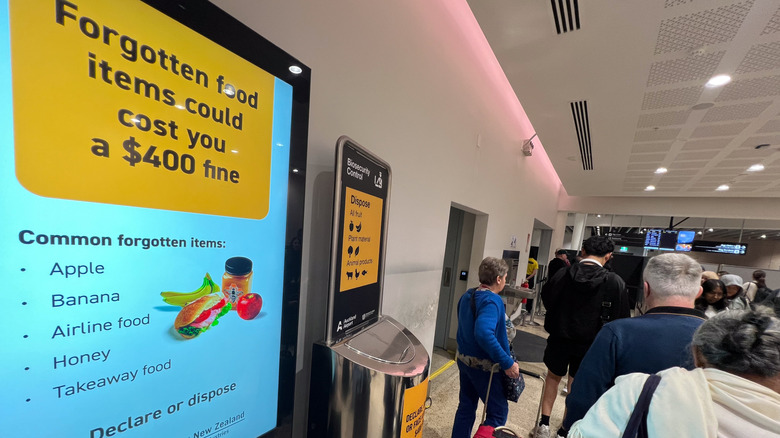The Luxury Appetizer TSA Lets You Bring Through Security To Your Flight With Zero Issues
No one likes paying an arm and a leg for a hamburger. Unfortunately, at many airports, food prices are notoriously high — and the selection may leave your stomach feeling worse than your wallet. Then, once you've boarded, you're torn between toughing it out or paying an exorbitant amount of money for a small snack box. While free lounge access is one way to fill up before your flight, it isn't a sure bet. One surefire way to solve a growling belly is to bring your own food. In fact, no matter which airline you fly, you can treat yourself (or your whole crew) to a guaranteed first-class experience with a homemade charcuterie board. After all, as long as you follow some basic TSA rules, you should have zero issues breezing past security with it in tow.
In general, the TSA is typically more concerned with dangerous items it considers a threat to security than with your lunch. Coolers (hard and soft) are allowed on board your flight; however, they will count toward your two-item allowance if they're packed separately. Similarly, solid foods — including meat, vegetables, fruit, hard cheese, and crackers — are all allowed through the security checkpoint. As long as everything meets the 3-1-1 rule (3 ounces of liquid, stored in a 1-quart-sized bag, and limited to one bag per traveler), even small amounts of cream cheese and spreads are fine, too.
That said, even though your food can make it through, the presentation of your charcuterie board might be a bit different on the fly. Instead of a flat board, you can pack your tasty bites in a sealable, compartmentalized, transparent container — like a craft box — and keep it in an easy-to-find location in your bag so it's easy to pull out once you're at the checkpoint.
Key TSA rules to follow before packing a charcuterie board
Unfortunately, the TSA security rules are annoyingly inconsistent on purpose. The individual TSA officer inspecting your luggage has the authority to deny items that are security threats, meaning a wooden board isn't a solid choice in this instance — pun intended. You'll also want to make sure to cut or slice all cold cuts before you leave, too, unless they can be cut with a plastic butter knife. Transport-wise, any ice packs keeping meat and cheese cold also have to be fully frozen, and will be allowed at the officer's discretion. If you're looking for a safe bet, hard cheeses, tapas plates (drained olives, prosciutto, bruschetta, and nuts) are all a fine choice. Along with that, hiking favorites — including trail mix, dried fruit, and jerky — are also allowed on domestic flights. However, if you're heading back to the continental U.S. or Alaska from Hawaii, note that fresh fruit will not be allowed through the USDA agricultural inspection station.
For something to sip on, your choices will be more limited. While you're allowed to bring an empty water bottle through security, wine or other beverages are not allowed. Small bottles of alcohol under 3.4 ounces technically meet the TSA requirements. However, it is against FAA regulations to bring or open your own alcohol bottles on board commercial flights, and penalties can cost tens of thousands of dollars. Nonetheless, you are more than welcome to savor your morsels on board your flight with an adult drink served by your flight attendant to fully enjoy your experience. Even if the rest of your body is in economy, your taste buds will enjoy their ticket to first class.
Eat up before landing
Food served in the skies is widely known for having a distinct taste. As such, you might be tempted to jazz up your charcuterie board with aromatic cheeses, zesty sauces, and dips to give your meal a zip. However, before you dive into your well-prepared treat, be mindful that you're sharing the enclosed space with dozens of other passengers, and that any aromas can linger in the cabin for hours due to air being recirculated.
Even if your charcuterie board breezes through TSA without a hitch, it may slow you down upon arrival if you're flying internationally. Although TSA rules are inconsistently enforced, customs and agricultural declarations have little wiggle room for negotiations — especially when it comes to potential biosecurity risks to a country's agricultural industries. For example, Australia and New Zealand do not allow any fresh fruit or opened meat and cheese products to enter the country. In fact, they require passengers to fill out a declaration card. Similarly, the European Union does not allow travelers to carry meat and cheese products from non-EU countries into the European Union; however, they are allowed on inter-EU flights.
Ultimately, before you pack up your first-class feast, be sure to check your destination's rules when it comes to importing food and food products. Also, make sure you finish every last bite and follow all of the local regulations. Not only will you make mom proud by cleaning your plate, but you'll also save yourself a lot of trouble in customs.


